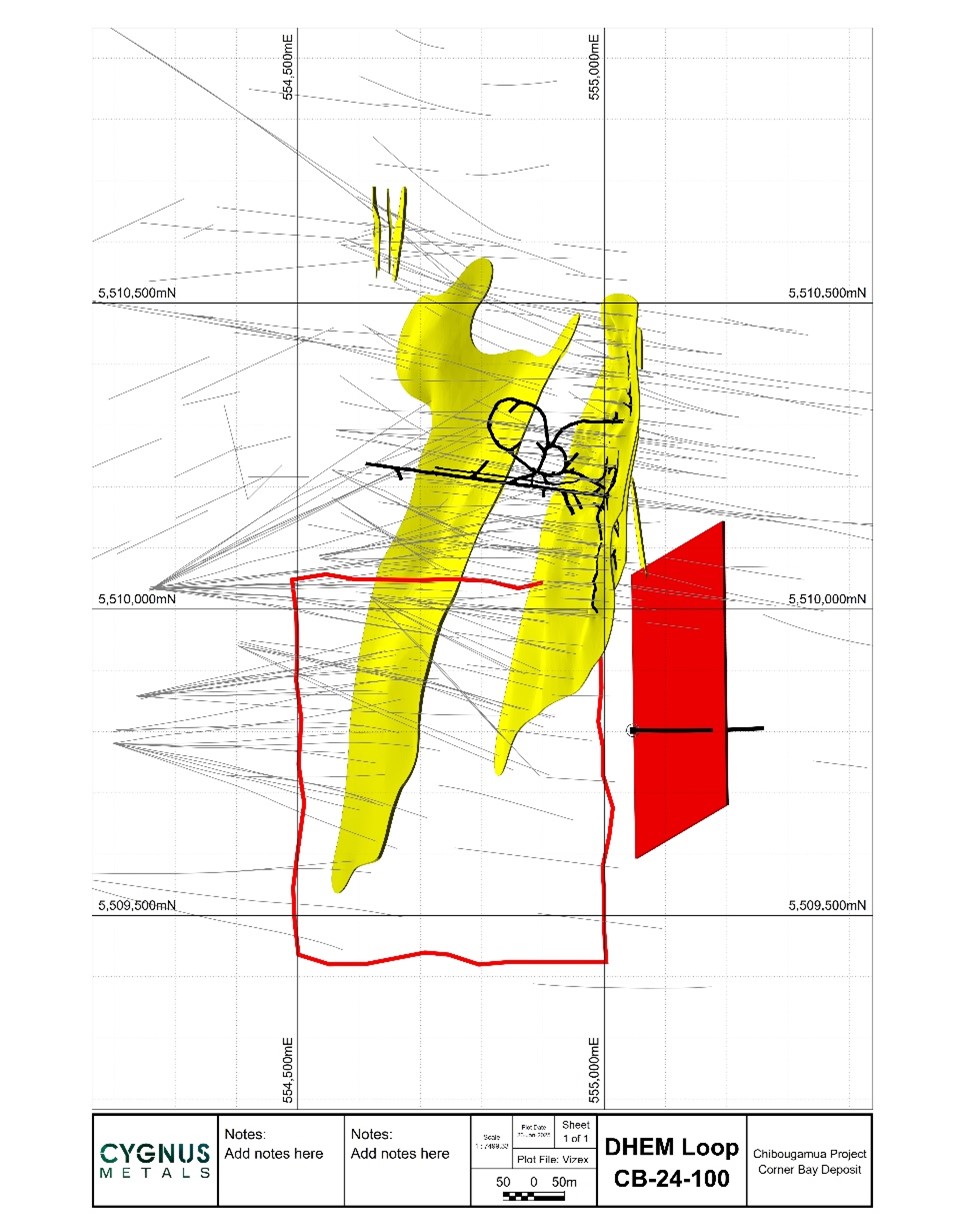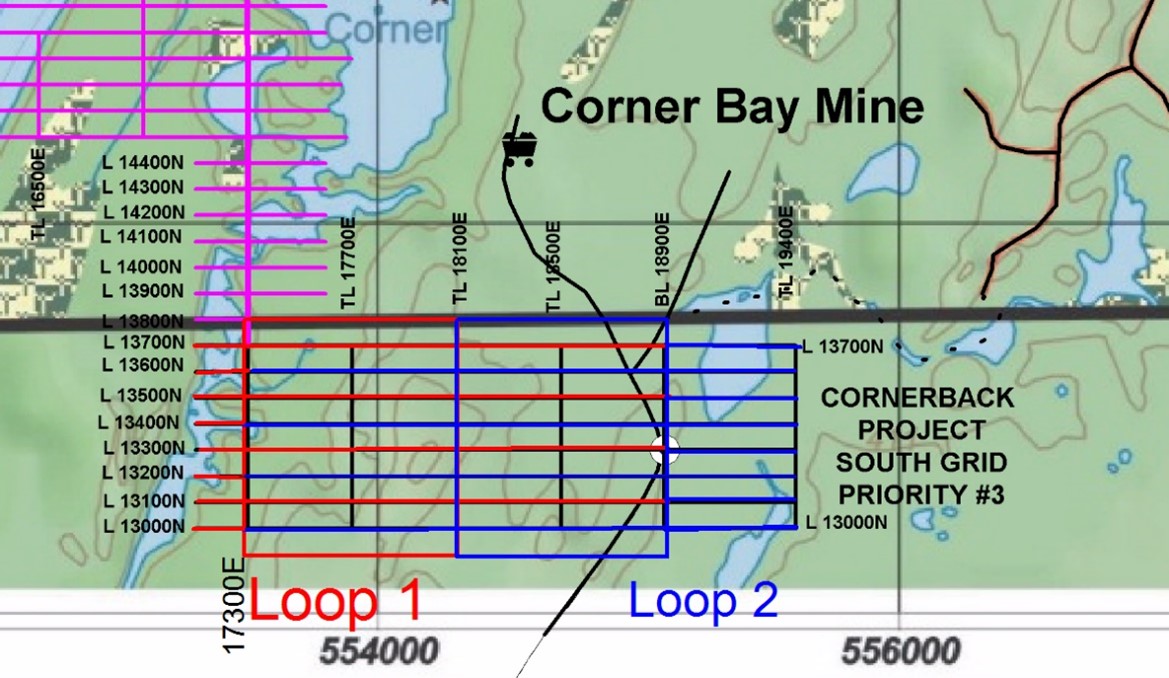PERTH, Australia and TORONTO, Jan. 28, 2025 (GLOBE NEWSWIRE) --
Cygnus Metals Limited (ASX: CY5; TSXV: CYG) ("Cygnus” or the "Company”) refers to its announcement titled "Cygnus increases highly prospective, under-explored ground position by 50%” released to ASX on 9 January 2025 ("First Announcement”) and its announcement titled "Cygnus' first drill hole returns up to 9.1% Cu outside Resource” released to ASX on 23 January 2025 ("Second Announcement”).
Clarifications regarding First Announcement
In discussions with the Company subsequent to the release of the First Announcement, the Australian Securities Exchange ("ASX”) has requested the below:
- Clarification regarding the assumptions used in the copper metal equivalents calculations provided by Cygnus on the NI 43-101 compliant Foreign Mineral Resource Estimate for the Chibougamau Project in the First Announcement; and
- Further information regarding metallurgical test work completed to support the Company's metallurgical recovery assumptions provided in this clarification announcement.
Note 6 of Appendix A on page 6 of the First Announcement is replaced with the following ("First Clarification”):
"Metal equivalents for the foreign estimate have been calculated at a copper price of US$8,750/t, gold price of US$2,350/oz. Copper equivalent was calculated based on the formula CuEq(%) = Cu(%) + (Au(g/t) x 0.77258). Metallurgical recovery factors have been applied to the copper equivalents calculation, with copper metallurgical recovery assumed at 95% and gold metallurgical recovery assumed at 85% based upon historical production at the Chibougamau Processing Facility and more recent metallurgical test work. It is the Company's view that all elements in the copper equivalent calculations have a reasonable potential to be recovered and sold.”
The Company confirms that the Foreign Mineral Resource Estimate and metal equivalents calculation do not contain any other metals, including silver. In fact, the inclusion of silver represents a further opportunity for the Company and will be reviewed in future work.
Other than the First Clarification above, there are no changes to the First Announcement.
In support of the First Clarification, attached to this announcement are the results of metallurgical test work previously completed by Doré.
Clarifications regarding Second Announcement
In discussions with the Company subsequent to the release of the Second Announcement, the ASX has requested that the Company provide further information regarding two of the three electromagnetic ("EM”) plates referred to in Figures 1 and 2 of the Second Announcement in accordance with ASX Listing Rules 5.6 and 5.7.
The Company wishes to note that the two additional untested EM plates to the south of the new EM plate referred to in the Second Announcement were identified from geophysics programs conducted by previous owners of the Chibougamau Project and provides the additional information set out in the Appendix to this clarification announcement ("Second Clarification”).
A fixed loop EM ("FLEM”) survey was conducted in 2007 by Crone Geophysics for Novawest Resources. Results from this survey, which Southern Geoscience Consultants ("SGC”) has reprocessed for Cygnus, highlighted a conductor to the south of the Corner Bay deposit. A downhole EM ("DHEM”) survey was conducted by Doré in 2021 on drillhole CB-21-93. The survey, which SGC has reprocessed for Cygnus, highlighted a further conductor to the south of the Corner Bay deposit.
Other than the Second Clarification, there are no changes to the Second Announcement.
This announcement has been authorised for release by the Board of Directors of Cygnus.
| David Southam Managing Director T: +61 8 6118 1627 | Ernest Mast President & Managing Director T: +1 647 921 0501 | Media:
Paul Armstrong Read Corporate +61 8 9388 1474 |
About Cygnus Metals
Cygnus Metals Limited (ASX: CY5, TSXV: CYG) is a diversified critical minerals exploration and development company with projects in Quebec, Canada and Western Australia. The Company is dedicated to advancing its Chibougamau Copper-Gold Project in Quebec with an aggressive exploration program to drive resource growth and develop a hub-and-spoke operation model with its centralised processing facility. In addition, Cygnus has quality lithium assets with significant exploration upside in the world-class James Bay district in Quebec, and REE and base metal projects in Western Australia. The Cygnus team has a proven track record of turning exploration success into production enterprises and creating shareholder value.
Qualified Persons and Compliance Statements
The scientific and technical information relating to metal equivalents in this news release has been reviewed and approved by Ms Laurence Huss, the Quebec In-Country Manager of Cygnus, a "qualified person” as defined in National Instrument 43-101 - Standards of Disclosure for Mineral Projects. The Company first announced the foreign estimate of mineralisation for the Chibougamau Project on 15 October 2024. The Company confirms that the supporting information included in the announcement of 15 October 2024 continues to apply other than in respect of the Clarification, and (notwithstanding the Clarification) has not materially changed.
Cygnus confirms that (notwithstanding the Clarification) it is not aware of any new information or data that materially affects the information included in the original announcement and that all material assumptions and technical parameters underpinning the estimates in the original announcement continue to apply and have not materially changed. Cygnus confirms that it is not in possession of any new information or data that materially impacts on the reliability of the estimates or Cygnus' ability to verify the foreign estimates as mineral resources in accordance with the JORC Code. The Company confirms that the form and context in which the Competent Persons' findings are presented have not been materially modified from the original market announcement.
The scientific and technical information relating to exploration results in this news release has been reviewed and approved by Mr Louis Beaupre, the Quebec Exploration Manager of Cygnus, a "qualified person” as defined in National Instrument 43-101 - Standards of Disclosure for Mineral Projects. The Exploration Results disclosed in this announcement are based on and fairly represent information and supporting documentation compiled by Mr Beaupre. Mr Beaupre holds options in Cygnus. Mr Beaupre is a member of the Ordre des ingenieurs du Quebec (P Eng), a Registered Overseas Professional Organisation as defined in the ASX Listing Rules, and has sufficient experience which is relevant to the style of mineralisation and type of deposits under consideration and to the activity which has been undertaken to qualify as a Competent Person as defined in the 2012 Edition of the "Australasian Code for Reporting of Exploration Results, Mineral Resources and Ore Reserves”. Mr Beaupre consents to the inclusion in this release of the matters based on the information in the form and context in which they appear.
Neither TSX Venture Exchange nor its Regulation Services Provider (as that term is defined in policies of the TSX Venture Exchange) accepts responsibility for the adequacy or accuracy of this release.
Appendix - Second Clarification
Section 1 (Sampling Techniques and Data) and Section 2 (Reporting of Exploration Results) of Appendix C (2012 JORC Table 1) of the Second Announcement are deleted and replaced as follows:
Section 1 Sampling Techniques and Data
| Criteria | JORC Code explanation | Commentary |
| Sampling techniques | Nature and quality of sampling (eg cut channels, random chips, or specific specialised industry standard measurement tools appropriate to the minerals under investigation, such as down hole gamma sondes, or handheld XRF instruments, etc). These examples should not be taken as limiting the broad meaning of sampling. |
|
| Include reference to measures taken to ensure sample representivity and the appropriate calibration of any measurement tools or systems used. |
| |
| Aspects of the determination of mineralisation that are Material to the Public Report. In cases where 'industry standard' work has been done this would be relatively simple (eg 'reverse circulation drilling was used to obtain 1 m samples from which 3 kg was pulverised to produce a 30 g charge for fire assay'). In other cases more explanation may be required, such as where there is coarse gold that has inherent sampling problems. Unusual commodities or mineralisation types (eg submarine nodules) may warrant disclosure of detailed information. |
| |
| Drilling techniques | Drill type (eg core, reverse circulation, open-hole hammer, rotary air blast, auger, Bangka, sonic, etc) and details (eg core diameter, triple or standard tube, depth of diamond tails, face-sampling bit or other type, whether core is oriented and if so, by what method, etc). |
|
| Drill sample recovery | Method of recording and assessing core and chip sample recoveries and results assessed. Measures taken to maximise sample recovery and ensure representative nature of the samples. Whether a relationship exists between sample recovery and grade and whether sample bias may have occurred due to preferential loss/gain of fine/coarse material. |
|
| Logging | Whether core and chip samples have been geologically and geotechnically logged to a level of detail to support appropriate Mineral Resource estimation, mining studies and metallurgical studies. |
|
| Whether logging is qualitative or quantitative in nature. Core (or costean, channel, etc) photography. |
| |
| The total length and percentage of the relevant intersections logged. |
| |
| Sub-sampling techniques and sample preparation | If core, whether cut or sawn and whether quarter, half or all core taken. If non-core, whether riffled, tube sampled, rotary split, etc and whether sampled wet or dry. For all sample types, the nature, quality and appropriateness of the sample preparation technique. Quality control procedures adopted for all sub-sampling stages to maximise representivity of samples. Measures taken to ensure that the sampling is representative of the in-situ material collected, including for instance results for field duplicate/second-half sampling. Whether sample sizes are appropriate to the grain size of the material being sampled. |
|
| Quality of assay data and laboratory tests | The nature, quality and appropriateness of the assaying and laboratory procedures used and whether the technique is considered partial or total. |
|
| For geophysical tools, spectrometers, handheld XRF instruments, etc, the parameters used in determining the analysis including instrument make and model, reading times, calibrations factors applied and their derivation, etc. |
| |
| Nature of quality control procedures adopted (eg standards, blanks, duplicates, external laboratory checks) and whether acceptable levels of accuracy (i.e. lack of bias) and precision have been established. |
| |
| Verification of sampling and assaying | The verification of significant intersections by either independent or alternative company personnel. |
|
| The use of twinned holes. |
| |
| Documentation of primary data, data entry procedures, data verification, data storage (physical and electronic) protocols. |
| |
| Discuss any adjustment to assay data. |
| |
| Location of data points | Accuracy and quality of surveys used to locate drill holes (collar and down-hole surveys), trenches, mine workings and other locations used in Mineral Resource estimation. |
|
| Specification of the grid system used. |
| |
| Quality and adequacy of topographic control. |
| |
| Data spacing and distribution | Data spacing for reporting of Exploration Results. |
|
| Whether the data spacing and distribution is sufficient to establish the degree of geological and grade continuity appropriate for the Mineral Resource and Ore Reserve estimation procedure(s) and classifications applied. |
| |
| Whether sample compositing has been applied. |
| |
| Orientation of data in relation to geological structure | Whether the orientation of sampling achieves unbiased sampling of possible structures and the extent to which this is known, considering the deposit type. |
|
| If the relationship between the drilling orientation and the orientation of key mineralised structures is considered to have introduced a sampling bias, this should be assessed and reported if material. |
| |
| Sample security | The measures taken to ensure sample security. |
|
| Audits or reviews | The results of any audits or reviews of sampling techniques and data. |
|
Section 2 Reporting of Exploration Results
(Criteria listed in the preceding section also apply to this section.)
| Criteria | JORC Code Explanation | Commentary |
| Mineral tenement and land tenure status | Type, reference name/number, location and ownership including agreements or material issues with third parties such as joint ventures, partnerships, overriding royalties, native title interests, historical sites, wilderness or national park and environmental settings. |
|
| The security of the tenure held at the time of reporting along with any known impediments to obtaining a licence to operate in the area. |
| |
| Exploration done by other parties | Acknowledgment and appraisal of exploration by other parties. |
|
| Geology | Deposit type, geological setting and style of mineralisation. |
|
| Drill hole Information | A summary of all information material to the understanding of the exploration results including a tabulation of the following information for all Material drill holes:
|
|
| Data aggregation methods | In reporting Exploration Results, weighting averaging techniques, maximum and/or minimum grade truncations (eg cutting of high grades) and cut-off grades are usually Material and should be stated. |
|
| Where aggregate intercepts incorporate short lengths of high-grade results and longer lengths of low-grade results, the procedure used for such aggregation should be stated and some typical examples of such aggregations should be shown in detail. |
| |
| The assumptions used for any reporting of metal equivalent values should be clearly stated. |
| |
| Relationship between mineralisation widths and intercept lengths | These relationships are particularly important in the reporting of Exploration Results. If the geometry of the mineralisation with respect to the drill hole angle is known, its nature should be reported. If it is not known and only the down hole lengths are reported, there should be a clear statement to this effect (eg 'down hole length, true width not known'). |
|
| Diagrams | Appropriate maps and sections (with scales) and tabulations of intercepts should be included for any significant discovery being reported These should include, but not be limited to a plan view of drill hole collar locations and appropriate sectional views. |
|
| Balanced reporting | Where comprehensive reporting of all Exploration Results is not practicable, representative reporting of both low and high grades and/or widths should be practiced to avoid misleading reporting of Exploration Results. |
|
| Other substantive exploration data | Other exploration data, if meaningful and material, should be reported including (but not limited to): geological observations; geophysical survey results; geochemical survey results; bulk samples - size and method of treatment; metallurgical test results; bulk density, groundwater, geotechnical and rock characteristics; potential deleterious or contaminating substances. |
|
| Further work | The nature and scale of planned further work (eg tests for lateral extensions or depth extensions or large-scale step-out drilling). Diagrams clearly highlighting the areas of possible extensions, including the main geological interpretations and future drilling areas, provided this information is not commercially sensitive. |
|
Image 1 below shows DHEM loop on CB-24-100

Image 2 below shows DHEM loop on CB-21-93 (red outline illustrates the EM loop and white line the location of drillhole CB-21-93)

Image 3 below illustrating loop and planned survey lines from 2007 FLEM (blues lines illustrate the planned survey lines for the anomaly outlined in the announcement)

Chibougamau Copper-Gold Project, Canada
Flotation copper recoveries of
up to 98.2% at Corner Bay
Metallurgical test work conducted at the Chibougamau Project indicates a high-quality clean concentrate with low impurities from the Corner Bay flagship asset
HIGHLIGHTS:
- Metallurgical test work at Corner Bay demonstrates:
- Copper recoveries of 98.2% and 96.8% from a sample from an ore sorting test
- High-quality copper concentrate grades results of 27.0% and 29.6%
- Clean concentrate with minimal deleterious elements
- Corner Bay is the flagship asset at the Chibougamau Project with an Indicated Mineral Resources of 2.7Mt at 2.9% CuEq and Inferred Mineral Resources of 5.9Mt at 3.6% CuEq1
- Metallurgical test work is being conducted as part of the ongoing study work at the Chibougamau Project
- Test work includes locked cycle flotation tests that approximate a future flowsheet
- The Chibougamau Project has excellent infrastructure with a 900,000tpa processing facility, local mining town, sealed highway, airport, regional rail infrastructure and 25kV hydro power to the processing site.
1 The Mineral Resource Estimate at the Chibougamau Project is a foreign estimate prepared in accordance with CIM Standards. A competent person has not done sufficient work to classify the foreign estimate as a mineral resource in accordance with the JORC Code, and it is uncertain whether further evaluation and exploration will result in an estimate reportable under the JORC Code.
| Cygnus Executive Chairman, David Southam said: "The results demonstrate the viability of the project as we continue along our dual track exploration and development pathway with high recoveries and a clean high grade concentrate”. |
Cygnus Metals Limited (ASX: CY5; TSXV: CYG) ("Cygnus” or the "Company”) is pleased to announce positive flotation test results at its flagship Corner Bay deposit within the Chibougamau Copper-Gold Project in Quebec, Canada.
The results have been released in connection with a response to a query from ASX concerning the basis on which Cygnus announced metal equivalent grades in an announcement dated 9 January 2025, which referred to its NI 43-101 compliant Foreign Mineral Resource Estimate for the Chibougamau Project ("Announcement”). The results of the metallurgical test program contained in this announcement have been considered by the Company in informing the metallurgical recovery rates contained in the Announcement and subsequent clarification announcement dated 28 January 2025. When Cygnus first disclosed the acquisition of Doré Copper Mining Corp on 15 October 2024, it did not consider that the metallurgical test-work was a material exploration result. Following queries from ASX, the Company has considered that the metallurgical test work contained in this announcement is information that is necessary to support the assumptions made about metal recoveries in Cygnus' copper equivalent statement in the Announcement.
This metallurgical test program conducted by Doré Copper Mining Corp. in 2023 was part of work designed to support ongoing study work at the Chibougamau Project.
The results demonstrate copper recoveries of 98.2% and 96.8% from a representative composite sample and high-quality copper concentrate grades results of 27.0% and 29.6%.
These results were previously released by Doré Coppe


